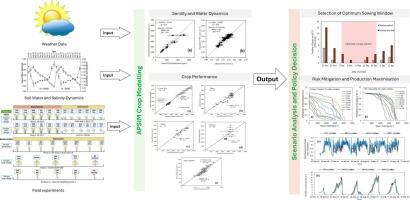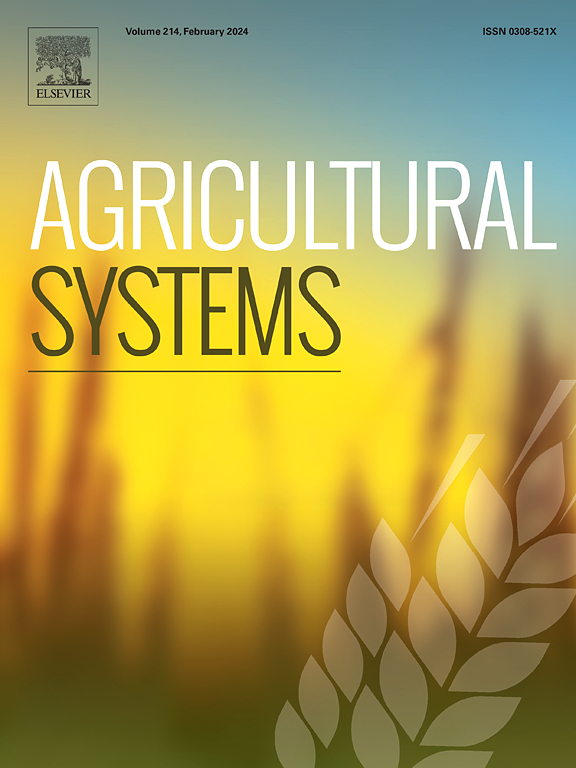Achieving the once-unthinkable: Successful Rabi cropping via technology integration in coastal saline Bengal
IF 6.1
1区 农林科学
Q1 AGRICULTURE, MULTIDISCIPLINARY
引用次数: 0
Abstract
Context
Agricultural productivity in the coastal saline zones of the Ganges Delta in Bangladesh and West Bengal, India faces significant constraints due to high soil salinity, seasonal waterlogging, freshwater scarcity, and increasing climatic variability. These challenges collectively limit the sustainability and intensification of dry season (Rabi) cropping systems, thereby impeding regional food security and livelihoods.
Objective
This study aimed to assess the key biophysical constraints affecting Rabi season cropping systems and to evaluate the integration of key agronomic and water management technologies using a combination of field experimentation and cropping systems modelling, with the goal of supporting climate-resilient intensification in coastal saline environments.
Method
Two years of field experimentation were conducted across multiple locations, generating a comprehensive validation dataset comprising 139 crop instances, including transplanted Aman (T. Aman) rice, wheat, maize, sunflower, grass pea, and lentil. These datasets represented a diverse range of potentially integratable technologies and agroecological conditions. The Agricultural Production Systems Simulator (APSIM), employing the APSIM-SWIM3 module, was used to simulate crop production outcomes for a range of different integrated technologies. To achieve this, a novel modelling approach was developed to dynamically simulate surface soil salinity and moisture, and then its subsequent effects on crop production, using daily inputs of water table depth, salinity, irrigation, and climatic data.
Results and conclusions
APSIM simulations closely matched observed field data, with performance metrics (RMSE, R2) falling within acceptable ranges of experimental uncertainty. Long-term (25-years) scenario analyses demonstrated that advancing sowing dates by 15–30 days could substantially increase yield potential by reducing salinity exposure during critical crop stages. However, early sowing increased the risk of waterlogging, especially in low-lying fields. In some cases, the incorporation of in-field drainage structures was shown to mitigate waterlogging risks effectively. In situations where this is not possible due to landscape constraints, model-based identification of optimal sowing periods provided a viable alternative to reduce risk of waterlogging. Additionally, the retention of crop residues was shown to reduce surface soil evaporation and salinity accumulation, increasing yield, particularly in late-sown Rabi crops.
Significance
Focusing on the integration of four key technologies— short-season improved Kharif rice varieties, early Rabi crop sowing, field drainage, and crop residue retention—this study delivers a validated, model-supported decision framework for enhancing Rabi cropping in coastal agroecosystems. The results offer a scalable foundation for site-specific agronomic planning, community-based water management, and policy formulation aimed at climate-resilient cropping system intensification in the vulnerable coastal saline regions of South Asia.

实现曾经不可想象的:通过技术整合在孟加拉沿海盐碱地成功种植拉比作物
孟加拉国和印度西孟加拉邦恒河三角洲沿海盐碱区的农业生产力面临着土壤高盐度、季节性内涝、淡水稀缺和气候变化加剧的严重制约。这些挑战共同限制了旱季(Rabi)种植系统的可持续性和集约化,从而阻碍了区域粮食安全和生计。本研究旨在通过田间试验和种植系统建模相结合的方法,评估影响Rabi季节种植系统的关键生物物理限制因素,并评估关键农艺和水管理技术的整合,以支持沿海盐碱化环境的气候适应性强化。方法在多个地点进行为期两年的田间试验,建立了包含139个作物实例的综合验证数据集,包括移栽的阿曼(T. Aman)水稻、小麦、玉米、向日葵、草豆和扁豆。这些数据集代表了各种可能整合的技术和农业生态条件。采用APSIM- swim3模块的农业生产系统模拟器(APSIM)用于模拟一系列不同综合技术的作物生产结果。为了实现这一目标,研究人员开发了一种新的建模方法,利用地下水位、盐度、灌溉和气候数据的日常输入,动态模拟表层土壤的盐度和湿度,然后模拟其对作物生产的后续影响。结果与结论sapsim模拟与现场观测数据非常吻合,性能指标(RMSE, R2)均在实验不确定性可接受范围内。长期(25年)情景分析表明,提前15-30天播种可以通过减少作物关键时期的盐度暴露,大幅提高产量潜力。然而,早播增加了涝渍的风险,特别是在低洼地区。在某些情况下,现场排水结构的结合被证明可以有效地减轻内涝风险。在由于景观限制而无法做到这一点的情况下,基于模型的最佳播种期识别为降低内涝风险提供了可行的替代方案。此外,作物残茬的滞留可减少表层土壤蒸发和盐分积累,提高产量,特别是后期播种的Rabi作物。本研究着眼于整合四项关键技术——短季改良的哈里夫水稻品种、拉比作物早期播种、田间排水和作物残茬保留——为沿海农业生态系统中提高拉比种植提供了一个经过验证的、模型支持的决策框架。研究结果为特定地点的农艺规划、基于社区的水资源管理和政策制定提供了可扩展的基础,旨在南亚脆弱的沿海盐碱区加强气候适应型种植系统。
本文章由计算机程序翻译,如有差异,请以英文原文为准。
求助全文
约1分钟内获得全文
求助全文
来源期刊

Agricultural Systems
农林科学-农业综合
CiteScore
13.30
自引率
7.60%
发文量
174
审稿时长
30 days
期刊介绍:
Agricultural Systems is an international journal that deals with interactions - among the components of agricultural systems, among hierarchical levels of agricultural systems, between agricultural and other land use systems, and between agricultural systems and their natural, social and economic environments.
The scope includes the development and application of systems analysis methodologies in the following areas:
Systems approaches in the sustainable intensification of agriculture; pathways for sustainable intensification; crop-livestock integration; farm-level resource allocation; quantification of benefits and trade-offs at farm to landscape levels; integrative, participatory and dynamic modelling approaches for qualitative and quantitative assessments of agricultural systems and decision making;
The interactions between agricultural and non-agricultural landscapes; the multiple services of agricultural systems; food security and the environment;
Global change and adaptation science; transformational adaptations as driven by changes in climate, policy, values and attitudes influencing the design of farming systems;
Development and application of farming systems design tools and methods for impact, scenario and case study analysis; managing the complexities of dynamic agricultural systems; innovation systems and multi stakeholder arrangements that support or promote change and (or) inform policy decisions.
 求助内容:
求助内容: 应助结果提醒方式:
应助结果提醒方式:


